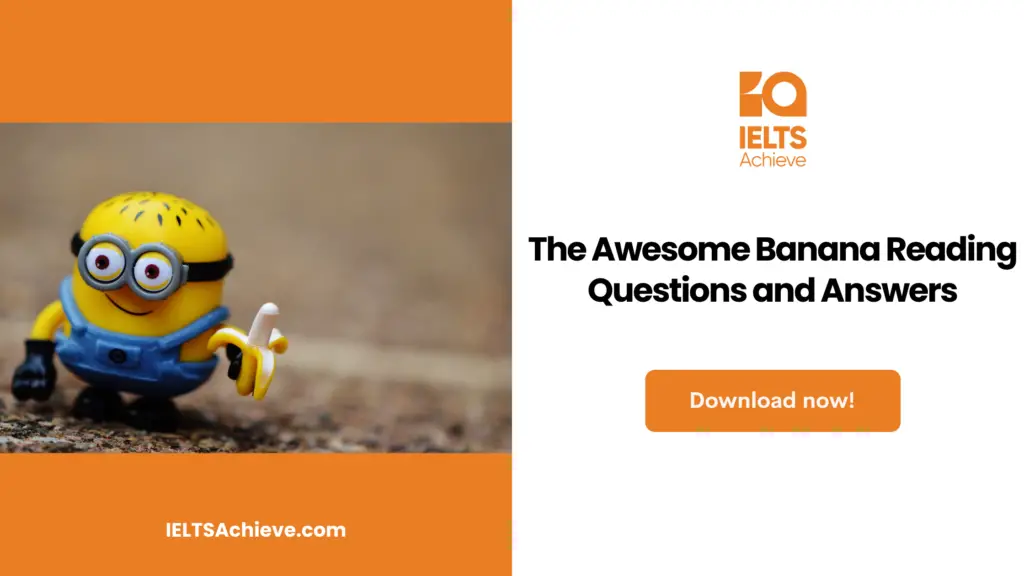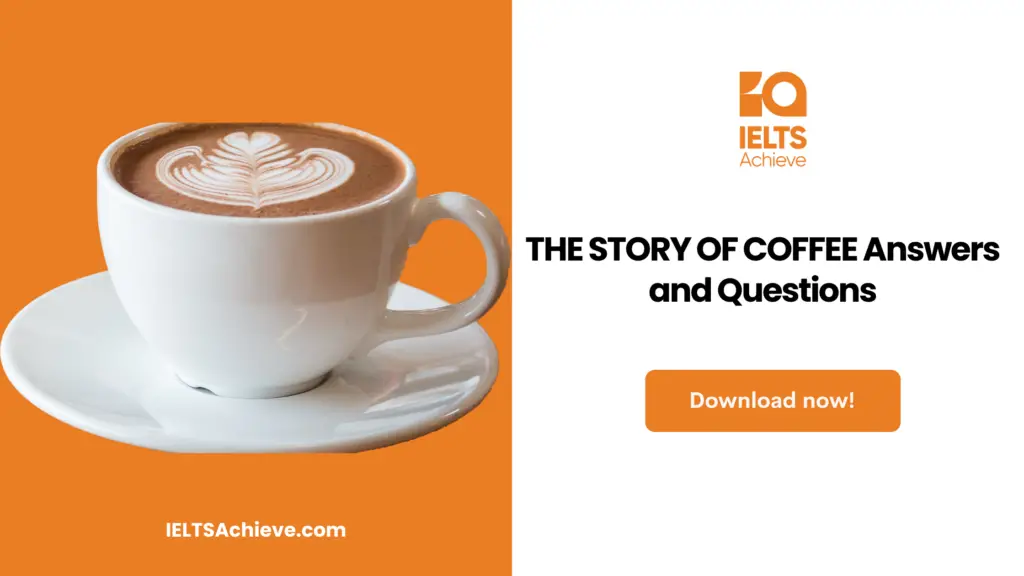The Blog post contains the following IELTS Reading Questions:
- IELTS Reading Sentence Completion
- IELTS Reading Matching Features
- IELTS Reading True/ False/ Not Given
Stay informed and prepared for success – Explore our comprehensive Reading Test Info page to get valuable insights, exam format details, and expert tips for mastering the IELTS Reading section.
IELTS reading passage – The awesome banana

The Awesome Banana
The most popular fruit in the world may be completely extinct in 10 years. One of the world’s oldest crops is the banana. Agronomists estimate that the first edible banana was found approximately ten thousand years ago. It has not changed since it began to spread in the South-East Asian forests at the end of the last ice age. Musa acuminata, a massive rainforest plant that produces wild bananas, is noted for having a large number of hard seeds that make the fruit inedible. Hunter-gatherers must, nevertheless, occasionally have discovered mutant plants that produced fruit without seeds. Geneticists now know that the vast majority of these plants that produce soft fruits have three copies of each chromosome instead of the usual two, which is the result of genetic errors. The mutant plants become infertile as a result of this imbalance, which prevents seeds and pollen from developing normally. And as a result, some scientists believe that the world’s most popular fruit may be doomed. It lacks the genetic diversity required to fend off the diseases and pests that are plaguing small farms in Africa and Asia as well as Central American banana plantations.
In some ways, modern bananas are analogous to Irish potatoes before the potato blight of the 1840s. Emile Frison of the International Network for the Improvement of Banana and Plantain in Montpellier, France, stated that when compared to this, “it provides a lesson for other crops as well.” Frison says that “the condition of the banana may convey a larger lesson: the increasing uniformity of food crops threatens their ability to adapt and prosper globally.” The earliest plant breeders in Stone Age Europe grew these mutated outcasts by grafting stem cuttings. These early cuttings have since produced the bananas we eat today. There is a striking lack of genetic diversity among them since each individual is essentially a carbon copy of every other. It is also more susceptible to disease than any other crop on Earth due to its extreme uniformity. All along, traditional cultivars of sexually reproducing plants have had a considerably broader genetic foundation, and new gene combinations appear with each new generation. This provides them with an abundance of genetic options from which to choose when responding to an attack or illness. However, this benefit is gradually dwindling as more and more farmers plant the same few high-yielding varieties. The efforts of plant breeders to maintain the resilience of these homogeneous crops are unceasing. If these efforts fail, the output of even the most bountiful crop might soon fall. According to Geoff Hawtin, director of the International Plant Genetic Resources Institute in Rome, severe epidemics can occur when a new pest or disease appears.
The banana is a nice illustration. One variety, the Gros Michel, dominated the global banana market before the 1950s. The Gros Michel banana was richer and sweeter than the typical banana of today and was bitter-tasting-free when green when it was first found by French botanists in Asia in the 1820s. However, it was prone to Panama disease, a soil fungus that produced wilt. A fungus will stay in the dirt for a long time once it has gotten there. Farmers have no other options. Even chemical spraying cannot completely remove it, according to Rodomiro Ortiz, director of the International Institute of Tropical Agriculture in Ibadan, Nigeria. In order to play cat and mouse, plantation owners left infected fields and moved to “clean” areas up until they ran out of “clean” land in the 1950s and had to abandon the Gros Michel. It was succeeded by the Cavendish banana, which is still the most popular commercial type today. The Cavendish banana was found in southern China by British explorers in the 19th century. The Cavendish saved the global banana industry because of its immunity to Panama disease. In the 1960s, it replaced the Gros Michel on grocery store shelves. If you buy a banana today, it will almost certainly be a Cavendish. However, it only accounts for a small portion of world banana output.
There are 500 million people in Asia and Africa that rely on bananas for sustenance. Regular consumption of bananas, which are high in calories, is recommended. Food is an abbreviation for its name. However, it seems that the day of reckoning may be at hand for the Cavendish and its local kin. Another fungus-related disease, black Sigatoka, has expanded globally since its identification in Fiji in 1963. Banana plant output drops from 30 years to as little as 2 or 3 if Black Sigatoka, which causes brown lesions on the leaves and early ripening of the fruit, is allowed to spread unchecked. Large-scale commercial growers employ a savage chemical assault to keep Sigatoka at bay. Forty anti-fungal sprayings a year is the norm. The use of fungicides has not alleviated the difficulty of managing illnesses like black Sigatoka. “As soon as you apply a new fungicide, they develop resistance,” says Frison. In this war, the Sigatoka cannot possibly lose. Poor farmers who cannot afford pesticides are in an even worse position. They are unable to prevent the death of their plants. Banana pathologist and EMBRAPA chief Luadir Gasparotto claim that “half of the banana crops in Amazonia have already been devastated by the sickness.” As the disease spreads, he predicts a 70 per cent loss in output. Your only hope is to discover a new kind.
But how? Since practically all edible bananas are susceptible to disease, banana growers are unable to simply switch to a different type. A swarm of breeders would invade the earth in quest of resistant relatives whose traits might be developed into commercial varieties if this happened to the majority of crops. Bananas, however, are an exception to this rule. Since all edible species are hermaphrodites, it is very challenging to introduce new genetic traits to combat diseases and pests. Not quite there yet, but close. Rarely, a sterile banana will have a genetic accident that results in the development of a nearly normal seed, giving breeders a little window for advancement. Breeders at the Honduran Foundation of Agricultural Research have investigated this tactic in an effort to create cultivars that are resistant to disease. By additional backcrossing with wild bananas, a unique seedless banana resistant to black Sigatoka and Panama disease was created.
Neither rural farmers nor city dwellers have warmed up to the new hybrid variety. Some people say it has an apple flavor rather than a banana flavor. For obvious reasons, most plant breeders have overlooked the banana in favor of easier species. The commercial banana industry is also increasingly rejecting the breeding program as a whole in favor of investing in the research and development of novel fungicides.”We supported a breeding effort for forty years, but no viable Cavendish successor developed. Ronald Romero, the chief of research at Chiquita, asserts that only three businesses control 90 percent of the global banana market “It was a costly endeavor with no returns. Frison and his international team of experts have announced that they want to sequence the banana genome within the next five years. The fruit would break new ground by becoming the first food item to have its DNA sequenced. Nearly fit for human consumption. The scientists will really be sequencing poisonous East Asian wild bananas, as many of them are resistant to black Sigatoka. Finding the genes responsible for these wild varieties’ resistance to black Sigatoka might pave the way for introducing this trait into lab-grown tissue cultures of edible types. Eventually, they may be nurtured into robust new plants that could be sent to farmers.
Although it appears to be promising on paper, big banana growers have been hesitant to take part in GM research due to their concern for their customer base. “Biotechnology is quite expensive and there are fundamental concerns over customer acceptance,” claims David McLaughlin, senior director for environmental affairs at Chiquita. Due to a dearth of funding from businesses, researchers studying the banana genome are focusing on the other end of the spectrum. Even if the required genes can be found, it will take a long time to develop new varieties that are appropriate for an inexpensive for smallholders. However, other than its scholarly fascination, the banana has nothing to rely on but biotechnology. Manufacturing will collapse due to a scarcity of bananas. The banana, the world’s most popular grocery item and a staple nourishment for millions of hungry and impoverished Africans may soon vanish from the shelves forever.
Unlock your full potential in the IELTS Reading section – Visit our IELTS Reading Practice Question Answer page now!
Recommended Questions:
Renewable Energy IELTS Reading Question with Answer
The awesome banana IELTS Reading Questions
Questions 1-3
Do the following statements agree with the information given in the Reading Passage? In boxes 1-3 on your answer sheet, write
TRUE if the statement agrees with the information
FALSE if the statement contradicts the information
NOT GIVEN if there is no information on this
- Even now, Gros Michel is employed as a component in several commercial products.
- The banana is the fruit that has been around the longest.
- In several nations, the banana serves as the primary source of nutrition.
Enhance your skills in identifying information as True, False, or Not Given. Click here to discover expert strategies and techniques for mastering this question type in the IELTS Reading section.
Questions 4-6
Complete the sentences below with NO MORE THAN THREE WORDS from the passage. Write your answers in the blank spaces next to 4-6 on your answer sheet.
4. A little over __________ years ago, humans first consumed bananas as a fruit.
5. __________ is where the banana was initially cultivated.
6. The taste of wild banana is caused by its __________.
Enhance your sentence completion skills in the IELTS Reading section. Click here to access our comprehensive guide and learn effective strategies for filling in missing words or phrases in sentences.
Questions 7-13
Match each statement with the correct person, A-F. Write the correct A-F letter in boxes 7-13 on your answer sheet. NB You may use any letter more than once.
7. The banana sector may take a significant hit if pests were to invade.
8. Infection by fungi in the soil frequently has long-lasting effects.
9. Manufacturers stopped working to develop disease-resistant varieties of bananas.
10. There is a possibility that the illness affecting bananas will become resistant to the chemical sprays.
11. Many banana plantations have been wiped off by disease.
12. Consumers are unlikely to accept crops that have been genetically modified.
13. The cultivation of different types of crops can benefit from studying bananas.
List of People
- Rodomiro
- David Mclaughlin
- Emile Frison
- Ronald Romero
- Luadir Gasparotto
- Geoff Hawtin
Improve your performance in Matching Features questions by clicking here to access our comprehensive guide. Learn how to match specific features or characteristics with the options provided in the IELTS Reading section.
Unlock your full potential in the IELTS Reading section – Visit our IELTS Reading Practice Question Answer page now!
Recommended Questions:
Renewable Energy IELTS Reading Question with Answer
The Awesome Banana Reading Answers
1. False
2. Not Given
3. True
4. Ten thousand
5. South-East Asia
6. Hard seeds
7. VI
8. I
9. IV
10. III
11. V
12. II
13. III

We hope you found this post useful in helping you to study for the IELTS Test. If you have any questions please let us know in the comments below or on the Facebook page.
The best way to keep up to date with posts like this is to like us on Facebook, then follow us on Instagram and Pinterest. If you need help preparing for the IELTS Test, join the IELTS Achieve Academy and see how we can assist you to achieve your desired band score. We offer an essay correction service, mock exams and online courses.

